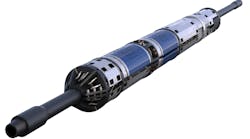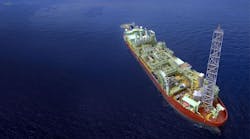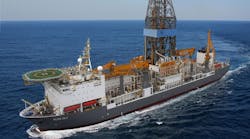Offshore staff
PORT STANLEY, Falkland Islands -- Rockhopper Exploration says it has proven a substantial oil column in its Sea Lion discovery in the North Falkland basin.
Its latest appraisal well (14/10-4) encountered 33 m (108 ft) net pay in a good quality reservoir. It also established an oil/water contact at 2,477 m (8,127 ft) TVD subsea in the main fan, which suggests that the southern main Sea Lion fan is full to spill.
This latest well aimed to investigate reservoir presence and the oil column at a downdip location. The results were close to Rockhopper’s geological prediction.
Top Sea Lion reservoir sands were encountered 66 m (216 ft) downdip from the 14/10-2 well, 2.3 km (1.4 mi) to the southeast. The program revealed 107 m (351 ft) of reservoir comprising four main sands, with average porosity of 20% and permeability of over 100 md.
Rockhopper adds that 30 m (98 ft) of net pay were intersected in the upper of the four sands, representing the main Sea Lion southern fan. The gross oil column now proven in the main Sea Lion southern fan is 104 m (341 ft).
In the lower sands 3 m (9.8 ft) of net oil pay is present. These thin sands are below the water leg of the upper sands, suggesting the presence of at least one additional oil column. They also confirm prospectivity for lower fan sequences developed elsewhere downdip.
A mini-DST was conducted using a dual-packer MDT tool over a 1-m (3.3-ft) interval at 2,486 m (8,156 ft) drilled depth within the oil column. This test flowed oil into the wellbore, providing additional samples and pressure build-up data, which suggest that flow rates and producibility here are better than at the discovery well.
A single MDT sample chamber was opened on the rig and initial wellsite analysis indicates a medium-grade oil similar to that in 14/10-2.
The rig team cut 57.5 m (189 ft) of conventional core in two cores from near the top of the reservoir. Data from these, wireline logs, seismic, and the wireline MDT test are being evaluated to establish reservoir extent across the area for both the Upper and Lower fan systems.
After plugging and abandoning the well, the semisub Ocean Guardian will next drill the Ninky prospect in the same basin for Desire Oil, before reverting to Rockhopper to drill a minimum of three further appraisal wells on the Sea Lion feature, and possibly more, along with further exploration wells.
Rockhopper now plans to start development planning for Sea Lion.
03/21/2011




